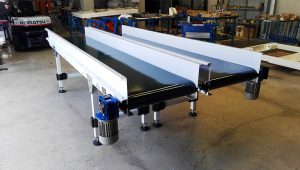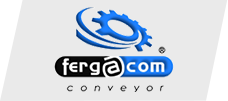Conveyor Belt Design
Conveyor belts are an essential tool in the industry for the transport of bulk materials. Whether in the food, mining, chemical or any other industry, conveyor belts are vital to the efficiency and productivity of the company. In this context,
Conveyor design is a critical process to ensure conveyor functionality, efficiency and safety.
What is conveyor belt design?
Conveyor design is the process of identifying a company’s material transportation requirements and creating a custom conveying solution that meets those needs. The design of conveyor belts involves the selection of suitable materials,
identifying the conveyor configuration and selecting custom features to meet specific needs. The ultimate goal of conveyor belt design is to create an efficient, safe, and cost-effective conveying solution.
Main design factors of conveyor belts
The main factors that must be taken into account in the design of conveyor belts are the following:
Loading capacity:
Load capacity is a critical factor in conveyor belt design.
The amount of material to be transported through the conveyor must be determined in order to select the proper load capacity.
Conveyor Belt Speed:
The speed of the conveyor belt must be carefully selected to ensure that materials are conveyed at the proper speed without overloading the conveyor belt.
Length And Width Of The Conveyor Belt:
The length and width of the conveyor belt must be designed to meet the specific needs of the company. The space available and the amount of materials to be transported must be taken into account.
Conveyor Belt Materials:
The selection of suitable materials for the conveyor belt is important to ensure the durability and strength of the conveyor belt. Consideration must be given to the nature of the materials to be conveyed and the environmental conditions in which the conveyor will be used.
Conveyor Belt Configuration:
The configuration of the conveyor belt must be designed to meet the specific needs of the company. This may include selection of conveyor location, conveyor height and incline, and selection of custom features,
such as side guides and loading and unloading hoppers.
Custom Features:
Custom features can include side guides, loading and unloading chutes, weight sensors, cleaning systems, and other features to suit specific needs.
The selection of custom features is important to ensure the efficiency and safety of the conveyor.
Benefits of Conveyor Belt Design
Custom conveyor design offers a number of benefits to businesses, including the following:
Improved Efficiency:
The customized design of the conveyor belt can significantly improve the efficiency of material transportation, which can reduce production costs and improve productivity.
Security Enhancement:
Custom conveyor design can also improve workplace safety by reducing personnel exposure to hazardous materials or minimizing the chance of injury or accident.
Product Quality Improvement:
Customized conveyor belt design can ensure materials are conveyed at the right speed and in the right way to ensure product quality.
Reduced Maintenance Costs:
Proper material selection and custom conveyor belt configuration can reduce long-term maintenance costs by ensuring conveyor belt durability and strength.
Improved Customer Satisfaction:
Improved efficiency and product quality can improve customer satisfaction, which can lead to increased business opportunities and customer loyalty.
Conclusions
In conclusion, custom conveyor design is a critical process to ensure functionality,
efficiency and safety of the conveyor belt. By carefully selecting the loading capacity, speed, length and width of the conveyor belt, the right materials, configuration and custom features, companies can improve the efficiency of transporting materials,
improve product quality, reduce maintenance costs and improve customer satisfaction. In addition, companies can improve workplace safety by minimizing personnel exposure to hazardous materials and reducing the chance of injury or accident. As a last resort,
Custom conveyor belt design can be a profitable and essential investment for any business that relies on the transportation of bulk materials.
It is important to note that custom conveyor design not only benefits companies that transport bulk materials,
but also to manufacturers of conveyor belts. By offering custom design services, manufacturers can set themselves apart from the competition and offer unique solutions to customers. Besides,
custom design can help manufacturers better understand customer needs and develop new technologies and solutions to meet those needs.
Another important factor to consider when designing custom conveyor belts is the implementation of innovative technologies.
Automation technologies, for example, can further improve conveyor belt efficiency by reducing the need for human intervention and improving the accuracy of material transport.
The implementation of monitoring and control technologies can also improve conveyor belt safety by enabling greater monitoring and prevention of failures.
Additionally, it is important to consider sustainability when designing custom conveyor belts. By selecting recycled and recyclable materials,
manufacturers and designers can reduce the environmental footprint of the conveyor belt and improve the sustainability of the material transport process.
In short, custom conveyor design is a critical process to ensure the efficiency, safety, and quality of bulk material transportation.
By carefully selecting the carrying capacity, speed, length and width of the conveyor belt, the right materials and customized configuration, companies can improve the efficiency of material transportation, improve product quality,
reduce maintenance costs and improve customer satisfaction. Additionally, the implementation of innovative and sustainable technologies can further improve the efficiency and sustainability of the materials transportation process. As a last resort,
Customized conveyor belt design is an essential investment for any business that relies on the transportation of bulk materials and can be an opportunity for manufacturers to differentiate themselves from the competition and develop new technology solutions.


